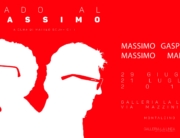On Saturday 13th of April at 6.00 pm, we are pleased to inaugurate the first solo exhibition of the painter Luca Rubegni.
The exhibition – entitled “Words that I haven’t told you” – which will remain open until the 5th of May – it will be presented by the texts written by Omar Galliani and Matteo Scuffiotti and will represents a journey into the recent artistic production on paper of the young roman artist.
During the vernissage will be offered for tasting the prestigious wines from the winery “La Fiorita” of Montalcino.
Luca Rubegni does not talk much. But he can observe and listen. He is twenty-five years old, but if you look at him well, it is twenty-five years about seventy years ago: in fact, even physically, he looks much more like Marcello Mastroianni than any of his contemporaries today.
If you are looking for him, you won’t find him on Facebook or on Instagram. That’s all it takes to decide to try and get to know him, but there is even more. Rarely have I met a person so “permeable” to emotions, so attentive to listening ( to himself in the first place ), constantly committed to isolating the “essence” from the background noises of existence and the unconscious. The artworks on paper presented in this exhibition represent a real “sieve” of his world, and are works made of writing and painting.
The author, indeed, is almost “ obsessed” by the continuous overlapping of these two instruments and expressive registers, in the perpetual attempt to giver shape – even for a moment – to the flashes of dreams and memories difficult to stop. For Rubegni writing is never a simple caption of what he paints, but – on the contrary – represents for the so-called “portal” through which gives the ability to connect to an “elsewhere”, which only his very intimate “spleen” has been able – at a given moment – to grasp. His colours are nothing more than “moods” and his paper is “skin”. After all, as Piero Manzoni used to say, “There is nothing to say: there is only to be, there is only to live”.
Matteo Scuffiotti
The return voyage of painting never ends. At the origin of the journey the colours are off, then they light up on Luca’s papers, where the words aspire to new tortuous and incessant trips. What remains of the landscapes that we have not yet seen and that perhaps we will never see in the nights of his painting?…There endures the opaque or shiny traces of
doing, searching for the immediacy of memory in the flights of the arm and hand, in showing that the thought escapes already “seen”, the already “said”. In the pilgrimage of the desires of “saying” without explaining… there where we would like ”to be” without being seen, Luca’s traces feed the papers in the becoming of a story without words, but full of clues to unveil/veil and walk together.
Omar Galliani







